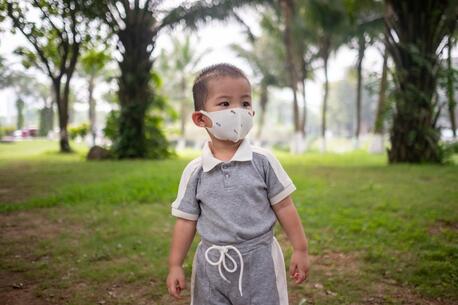
Report: Air Pollution Now No. 2 Killer of Children Under 5
A comprehensive new report details the health impacts of air pollution, which accounted for 8.1 million deaths globally in 2021 — including 700,000 children under age 5, making it the second-leading risk factor for death globally for this age group, after malnutrition.
Nearly every person on Earth is breathing unhealthy levels of air pollution every day — with far-reaching health implications
Air pollution is having an increasing impact on human health, becoming the second leading global risk factor for death, according to the fifth edition of the State of Global Air (SoGA) report.
The report, released by the Health Effects Institute (HEI), an independent U.S.-based nonprofit research organization, found that air pollution accounted for 8.1 million deaths globally in 2021.
Beyond these deaths, many more millions of people are living with debilitating chronic diseases, putting tremendous strains on health care systems, economies and societies.
Children under age 5 especially vulnerable
Produced for the first time in partnership with UNICEF, the report finds that children under age 5 are especially vulnerable, with health effects including premature birth, low birth weight, asthma and lung diseases.
In 2021, exposure to air pollution was linked to more than 700,000 deaths of children under 5, making it the second-leading risk factor for death globally for this age group after malnutrition.
A staggering 500,000 of these child deaths were linked to household air pollution due to cooking indoors with polluting fuels, mostly in Africa and Asia.
The new SoGA Report offers a detailed analysis of recently released data from the Global Burden of Disease study from 2021 that shows the severe health impacts pollutants like outdoor fine particulate matter (PM2.5), household air pollution, ozone (O3) and nitrogen dioxide (NO2) are having on human health around the world.
An analysis of data from more than 200 countries
The report includes data for more than 200 countries and territories around the world, indicating that nearly every person on earth breathes unhealthy levels of air pollution every day, with far-reaching health implications.
More than 90 per cent of these global air pollution deaths – 7.8 million people – are attributed to PM2.5 air pollution, including from ambient PM2.5 and household air pollution. These tiny particles, measuring less than 2.5 micrometers in diameter, are so small they remain in the lungs and can enter the bloodstream, affecting many organ systems and increasing the risks for noncommunicable diseases (NCDs) in adults like heart disease, stroke, diabetes, lung cancer and chronic obstructive pulmonary disease (COPD).
According to the report, PM2.5 has been found to be the most consistent and accurate predictor of poor health outcomes around the world.
“We hope our State of Global Air report provides both the information and the inspiration for change,” said HEI President Dr. Elena Craft. “Air pollution has enormous implications for health. We know that improving air quality and global public health is practical and achievable.”
We know that improving air quality and global public health is practical and achievable. — Health Effects Institute President Dr. Elena Craft
Connection to climate change
PM2.5 air pollution comes from the burning of fossil fuels and biomass in sectors such as transportation, residential homes, coal-burning power plants, industrial activities and wildfires. These emissions not only impact people’s health but also contribute to the greenhouse gases that are warming the planet. The most vulnerable populations are disproportionately affected by both climate hazards and polluted air.
In 2021, long-term exposure to ozone contributed to an estimated 489,518 deaths globally, including 14,000 ozone-related COPD deaths in the United States, higher than other high-income countries. As the world continues to warm from the effects of climate change, areas with high levels of NO2 can expect to see higher levels of ozone, bringing even greater health effects.
For the first time, this year’s report includes exposure levels and related health effects of nitrogen dioxide (NO2), including the impact of NO2 exposures on the development of childhood asthma. Traffic exhaust is a major source of NO2, which means densely populated urban areas, particularly in high-income countries, often see the highest levels of NO2 exposures and health impacts.
“This new report offers a stark reminder of the significant impacts air pollution has on human health, with far too much of the burden borne by young children, older populations, and low- and middle-income countries,” said Dr. Pallavi Pant, HEI’s Head of Global Health who oversaw the SoGA report release.
“This points sharply at an opportunity for cities and countries to consider air quality and air pollution as high-risk factors when developing health policies and other noncommunicable disease prevention and control programs.”

Exposure to air pollution in young children linked to pneumonia, asthma
Some of the greatest health impacts of air pollution are seen in children. Children are uniquely vulnerable to air pollution and the damage from air pollution can start in the womb with health effects that can last a lifetime. For example, children inhale more air per kilogram of body weight and absorb more pollutants relative to adults while their lungs, bodies and brains are still developing.
Exposure to air pollution in young children is linked to pneumonia, responsible for 1 in 5 child deaths globally, and asthma, the most common chronic respiratory disease in older children.
The inequities linked to the impact of air pollution on child health are striking. The air pollution-linked death rate in children under 5 in East, West, Central and Southern Africa, for example, is 100 times higher than their counterparts in high-income countries.
“Despite progress in maternal and child health, every day almost 2,000 children under five years die because of health impacts linked to air pollution,” said UNICEF Deputy Executive Director Kitty van der Heijden. “Our inaction is having profound effects on the next generation, with lifelong health and well-being impacts. The global urgency is undeniable. It is imperative governments and businesses consider these estimates and locally available data and use it to inform meaningful, child-focused action to reduce air pollution and protect children’s health.”
Despite progress in maternal and child health, every day almost 2,000 children under five years die because of health impacts linked to air pollution. Our inaction is having profound effects on the next generation. — Kitty van der Heijden, UNICEF Deputy Executive Director
Air quality actions in Africa, Latin America and Asia making progress, but more can be done
There is some good news in the report too. Since 2000, the death rate linked to children under 5 has dropped by 53 percent, due largely to efforts aimed at expanding access to clean energy for cooking, as well as improvements in access to health care and nutrition, and better awareness about the harms associated with exposure to household air pollution.
Many countries, particularly those experiencing the highest levels of air pollution, are finally tackling the problem head on. Air quality actions in regions like Africa, Latin America, and Asia — such as installing air pollution monitoring networks, implementing stricter air quality policies, or offsetting traffic-related air pollution by moving to hybrid or electric vehicles — are all having measurable impacts on pollution and improving public health.
While progress is being measured, more can be done to stop air pollution from continuing to outrank other health risks as one of the biggest threats to millions of lives.